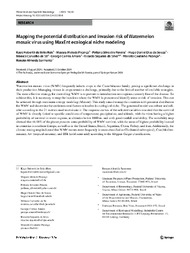Embrapa Roraima
Publications
Mapping the potential distribution and invasion risk of Watermelon mosaic virus using MaxEnt ecological niche modeling.
Author(s): REIS, K. H. D.; PICANÇO, M. M.; PEREIRA, P. S.; SOUZA, H. D. D. de; SÁ, M. C. de; AMARO, G. C.; SILVA, R. S. da; PICANÇO, M. C.; SARMENTO, R. A.
Summary: Watermelon mosaic virus (WMV) frequently infects crops in the Cucurbitaceae family, posing a significant challenge in their production. Managing viruses in crops remain a challenge, primarily due to the limited number of available strategies. The most effective strategy for controlling WMV is to prevent its introduction into regions currently free of the disease. To achieve this, it is necessary to map the locations where the WMV is present and identify areas at risk of invasion. This can be achieved through maximum entropy modeling (Maxent). This study aimed to map the countries with potential distribution for WMV and determine the environmental factors related to its ecological niche. The generated model was robust and reli- able according to the 21 metrics used to evaluate it. The response curves of the selected variables revealed that the survival of WMV is directly linked to specific conditions of temperature, precipitation, and altitude, with the virus having a higher probability of survival in warm regions, at altitudes below 1000 m, and with good rainfall availability. The suitability map showed that 46.08% of the planet presents some probability of WMV survival, with the areas of highest probability located in countries in southern Europe, as well as in the United States, Brazil, Argentina, China, Turkey, and Iran. Additionally, the climate zoning map indicated that WMV occurs most frequently in areas classified as Cfa (humid subtropical), Csa (Mediter- ranean), Aw (tropical savanna), and BSk (cold semi-arid) according to the Köppen-Geiger classification
Publication year: 2025
Types of publication: Journal article
Unit: Embrapa Roraima
